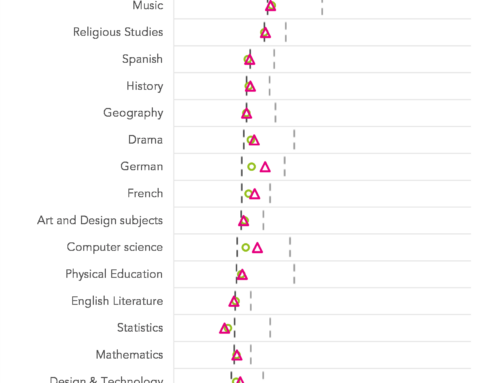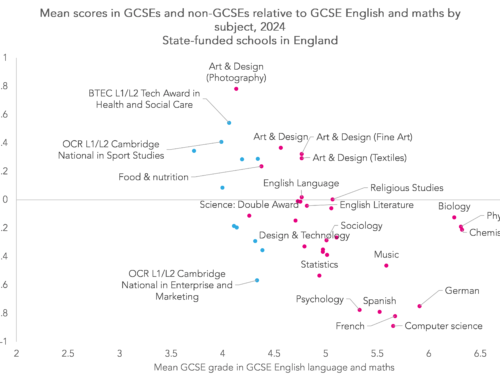In this post, we’re going to look at A-Level subject combinations. There’s a lot of information already out there about A-Level entries in each subject, but not so much about combinations of subjects.
We’ll be using data on students who took A-Levels in 2019 (the most recent year for which data is available). In that year, 258,471 students in England took at least one A-Level. The majority of these studied three or more subjects, but 10% took just one subject and 16% took two. Later on, we’ll look at BTECs taken alongside A-Levels. But we’ll start by looking at the A-Level subject combinations chosen by those students who took two or more A-Levels.
Subject pairings
Some subjects are very frequently matched with others. This is particularly noticeable in the STEM subjects.[1] Of those who took physics, for example, 83% (28,158 students) also chose to study maths. A-Level chemists are much more likely to take biology (66%) or maths (57%) than any other subjects.
Even biology, which tends to be paired with a broader range of subjects than the other sciences, is taken alongside chemistry by the majority of students (57%).
In contrast, the most popular choice for art and design students was psychology, but that was chosen by just 16% of the art and design cohort (5,201 students).
The chart below allows you to explore the top ten most popular second choices by subject.
Combinations of three or more subjects
We can dig down a bit further to look at how subjects are matched together into groups of three or more. In the chart below, we show the top ten most popular subject combinations in 2019, for students who took three or more A-Levels.

The top choice, biology, chemistry and maths, was a runaway winner, taken by more than twice as many students as the second most popular option. The list is dominated by STEM subjects: only one combination not including any STEM subjects (English literature, history and psychology) is included in the top ten. This may be driven by the requirements of some university courses or careers paths. Medical degrees, for example, generally require both biology and chemistry, but it’s less common for a non-STEM degree to require more than one subject at A-Level.
Some trends over the last three years
In 2019, there were three subject combinations that were far more popular than any others: biology, chemistry and maths; chemistry, maths and physics; and biology, chemistry and psychology. But how enduring is that popularity?
In the chart below, we show the number of A-Level students who chose to study these three combinations in each year from 2017-19.

While all three combinations were very popular in every year we looked at, the number of students choosing them increased each year.
BTECs and A-Levels
So far, we’ve focused on how A-Levels are combined with other A-Levels. But A-Levels are also combined with other types of qualifications, notably BTECs. In 2019, 13% of A-Level students (34,381 students) also took at least one BTEC. These were split almost evenly between students who took one A-Level alongside their BTEC(s) (48%) and those who took two (50%), although a very small minority took three or more A-Levels with a BTEC.
The chart below shows the number of A-Level students in each subject who also studied at least one BTEC.

Some subjects, such as further maths and German, were almost never paired with BTECs; less than 1% of further maths students also took a BTEC. At the other end of the scale, psychology, sociology and art and design were the top choices for those combining A-Levels with BTECs.
Finally, we’ll look at the most popular BTEC / A-Level subject combinations. The ten most popular choices are shown in the chart below.

Combinations involving a BTEC in health studies or applied sciences and a social science A-Level were popular. Business studies – the most popular BTEC overall – was matched with A-Levels in a range of subjects, with social sciences, art and design, and media, film or TV studies the most popular.
Summing up
The most popular A-Level subject combinations by far are those involving STEM subjects, probably because of the requirements of both university courses and some schools and colleges. Some all-STEM combinations, like biology, chemistry and maths, have only been getting more popular in the last three years. On the other hand, broader combinations involving two STEM subjects and a social science or humanities subject are also common, especially when they include that inseparable pair, biology and chemistry.
Some A-Levels are often taken alongside BTECs, particularly psychology, sociology and art and design. The most popular BTEC / A-Level combinations involve a BTEC in health studies and an A-Level in a social science. Again, this may reflect the requirements of some universities or career paths.
1. Here, we’re defining STEM as: biology, chemistry, physics, computing and maths.







Your data did not show Biology/Chemistry/Physics subjects combination at A Level. Is there a reason for this?
Hello, thanks for commenting. We’ve only shown the top ten most popular combinations of three or more subjects – and, perhaps surprisingly, Biology/Chemistry/Physics isn’t in the top ten. Biology/Physics is actually a relatively unusual combination, certainly compared to Biology/Chemistry, Physics/Chemistry or Physics/Maths.
I think this is really interesting. The combination of subjects is rarely looked at but so important. I don’t think most people realise the huge variety in combinations, preferring to think there are simple routes and combinations. It shows why post-16 timetabling is such a challenge and illustrates to those advising Y11s that they can think creatively about combinations. It’s great to see you looking at A Level/BTEC combinations too. These are so important in supporting a huge number of young people into the career they want.
Thanks Dominic, that is good to hear! We did think that this was a very interesting area that doesn’t get much attention usually. The Cambridge Assessment report mentioned below is well worth a read as well.
Thanks for sharing this blog. We have also previously carried out research in this area and released a report titled ‘Uptake of GCE A Level subjects 2017’. The report included the ten most common combinations of at least 3 A Level subjects. https://www.cambridgeassessment.org.uk/Images/518880-uptake-of-gce-a-level-subjects-2017.pdf
Aha, I did see the Cambridge Assessment report when I was writing this up. Thanks for sharing the link. I think the only combination included in our 2019 top ten that doesn’t also appear in your 2017 top ten is biology/chemistry/history – although I imagine that fell only just outside the top ten.
Hello. It would be interesting to see the ‘top ten least popular combinations’. In the era of STEAM as a progression from STEM, do you have any charts to address this? For example, I did Art/physics/mathematics for A-level. How would combinations such as this fit into your charts/research? Perhaps the least popular combinations would be just as ‘telling’ as the most popular? I’d appreciate your comment. 🙂
Hi Victoria. Yes, I definitely agree that it’s interesting to think about the less popular combinations too. The trouble is that there are so many different possible combinations that it’s impossible to look at them all in one post! We can’t really do a ‘ten least popular combinations’ or similar because there are some combinations – and some individual A-level subjects – with a really low number of entries, ie double or even single figures. For this post we only looked at combinations taken by at least 100 students.
I actually suspect that art / physics / maths is a more popular combination than some might think – it’s a good one for architecture or similar careers. The question about STEAM more generally is interesting too. I don’t really have a sense of whether STEAM combinations have become more popular in recent years. Perhaps something to think about for a future post…
Hi I am not seeing accounting and computer science. any particular reason?
Hi there. For this post we grouped subjects in the same way as JCQ does when publishing exam results (www.jcq.org.uk/examination-results/). So we’ve grouped together A-Levels in Computer Science, Computing etc as ‘Computing’. Accounting is one of the subjects that JCQ doesn’t publish individual data on because of low entry numbers, so we’ve not included it here.
Hi Natasha – thanks for this article. I have been researching the take-up of computer science (in particular by girls at GCSE and A-level), and the combination of subjects at A-level is particularly interesting.
I have tried to visualise the data you provided in d3.js; the code (and more detail on data I filtered out) is at https://observablehq.com/d/4ace19cabed0df12.
With a bit of manual tweaking I get the result shown at https://static.observableusercontent.com/files/7a9b86145df64282ee7ef13991a9f50da8e8f2f2bc666638157cef296be0f3e2651dc925ac042df79ab34f33deba763d926450bd05f83aa9434528c146502a64?response-content-disposition=inline%3Bfilename*%3DUTF-8%27%27a-levels-2019-edited.pdf
It’s interesting because it shows how computer science is “out on a limb” whereas the (new at A-level) psychology is so well connected.